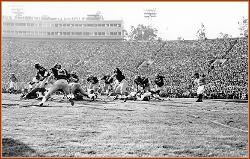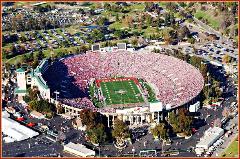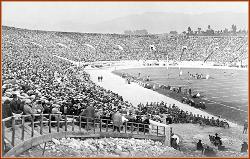




The city of San Francisco received a new incentive to get a new stadium built. Mayor Gavin Newsom wanted to bring the 2016 Summer Olympics
to the city, and a new stadium would sweeten the city's proposal for selection by the United States Olympic Committee as the official US
submission to the IOC. The announcement came in November, 2006, with the new 49ers stadium as the centerpiece of an Olympics bid, and the
construction of the Olympic village would be converted into low-income housing after the games were over.
The project planning did not get off to a good start, however, with contention between the 49ers and the city of San Francisco over viable
locations for the new stadium. Initially, the idea was to build a stadium in the parking lot of Monster Park and later demolish the aging stadium.
Team ownership feared that construction of the village and the stadium would severely limit the amount of land available in Candlestick Point,
creating a parking problem for fans and increasing traffic along the only two-lane road that links the stadium to the freeway. Moreover, with
residents in the low-income housing by 2016, traffic would be increased indefinitely, further damaging the already-limited methods of
transportation to the park.
With San Francisco slow to come up with better locations for the stadium or ways to circumvent the problems posed by a construction at
Candlestick Point, team owners Denise DeBartolo York and John York announced on November 9, 2006, that the 49ers were shifting its efforts to
create a new stadium to the city of Santa Clara, approximately 40 miles south of San Francisco. In recent years, an increased percentage of fans
were concentrated in the South Bay, and with the 49ers training facility already in Santa Clara, a stadium move would center all 49ers operations
in the same city. The stadium would be located in a lot across the street from the training facility, nearby Paramount's Great America theme park,
and close to many transportation links, including a freeway, bus lines, and rail service. Earlier in the 2006 football season, NFL Commissioner
Roger Goodell gave an unofficial green-light, calling it a "no-brainer" to construct the stadium at the Santa Clara site, citing all the benefits stated
above.
The sudden removal of the planned stadium forced the San Francisco Olympics bid group to cancel its proposal, which engendered great anger
from Mayor Newsom. In addition, many fans were outraged at the suggestion to move the 49ers out of the city that it had shared history with for
decades. The Yorks insisted that the legacy of the franchise would be respected in the sense that the 49ers would not be renamed nor moved
out of the Bay Area. This was met with much opposition from Mayor Newsom and Senator Dianne Feinstein (who was mayor of San Francisco
between 1978 and 1988); the senator stated that the team should be unable to use the San Francisco name if its operations were not based in
the city. On January 3, 2007, California State Senator Carole Migden introduced a bill, entitled SB49, that would bar the 49ers from building a
new stadium within a 100 mile radius of San Francisco, if they were to leave the city. The 49ers organization announced their strong opposition to
the legislation and retorted that the passage of such a bill would only encourage the team to move out of the Bay Area altogether.
Despite the political troubles, the 49ers are still in talks with San Francisco of finding an acceptable location, but with advantageous
transportation links in the Santa Clara location and a unanimous decision by the Santa Clara city council on January 9th to conduct a six-month
feasibility study, the time is ticking for the city of San Francisco to come up with alternatives.





